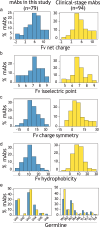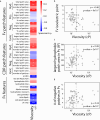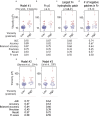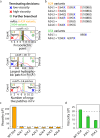Reduction of monoclonal antibody viscosity using interpretable machine learning
- PMID: 38475982
- PMCID: PMC10939158
- DOI: 10.1080/19420862.2024.2303781
Reduction of monoclonal antibody viscosity using interpretable machine learning
Abstract
Early identification of antibody candidates with drug-like properties is essential for simplifying the development of safe and effective antibody therapeutics. For subcutaneous administration, it is important to identify candidates with low self-association to enable their formulation at high concentration while maintaining low viscosity, opalescence, and aggregation. Here, we report an interpretable machine learning model for predicting antibody (IgG1) variants with low viscosity using only the sequences of their variable (Fv) regions. Our model was trained on antibody viscosity data (>100 mg/mL mAb concentration) obtained at a common formulation pH (pH 5.2), and it identifies three key Fv features of antibodies linked to viscosity, namely their isoelectric points, hydrophobic patch sizes, and numbers of negatively charged patches. Of the three features, most predicted antibodies at risk for high viscosity, including antibodies with diverse antibody germlines in our study (79 mAbs) as well as clinical-stage IgG1s (94 mAbs), are those with low Fv isoelectric points (Fv pIs < 6.3). Our model identifies viscous antibodies with relatively high accuracy not only in our training and test sets, but also for previously reported data. Importantly, we show that the interpretable nature of the model enables the design of mutations that significantly reduce antibody viscosity, which we confirmed experimentally. We expect that this approach can be readily integrated into the drug development process to reduce the need for experimental viscosity screening and improve the identification of antibody candidates with drug-like properties.
Keywords: Antibody engineering; Fv; charge; computation; developability; formulation; hydrophobicity; in silico; isoelectric point; mutation.
Conflict of interest statement
No potential conflict of interest was reported by the author(s).
Figures








Similar articles
-
Antibodies with Weakly Basic Isoelectric Points Minimize Trade-offs between Formulation and Physiological Colloidal Properties.Mol Pharm. 2022 Mar 7;19(3):775-787. doi: 10.1021/acs.molpharmaceut.1c00373. Epub 2022 Feb 2. Mol Pharm. 2022. PMID: 35108018 Free PMC article.
-
Rational design of viscosity reducing mutants of a monoclonal antibody: hydrophobic versus electrostatic inter-molecular interactions.MAbs. 2015;7(1):212-30. doi: 10.4161/19420862.2014.985504. MAbs. 2015. PMID: 25559441 Free PMC article.
-
Mitigation of reversible self-association and viscosity in a human IgG1 monoclonal antibody by rational, structure-guided Fv engineering.MAbs. 2016 Jul;8(5):941-50. doi: 10.1080/19420862.2016.1171444. Epub 2016 Apr 6. MAbs. 2016. PMID: 27050875 Free PMC article.
-
An accelerated surface-mediated stress assay of antibody instability for developability studies.MAbs. 2020 Jan-Dec;12(1):1815995. doi: 10.1080/19420862.2020.1815995. MAbs. 2020. PMID: 32954930 Free PMC article. Review.
-
Molecular basis of high viscosity in concentrated antibody solutions: Strategies for high concentration drug product development.MAbs. 2016;8(2):216-28. doi: 10.1080/19420862.2015.1128606. Epub 2016 Jan 6. MAbs. 2016. PMID: 26736022 Free PMC article. Review.
Cited by
-
PROPERMAB: an integrative framework for in silico prediction of antibody developability using machine learning.MAbs. 2025 Dec;17(1):2474521. doi: 10.1080/19420862.2025.2474521. Epub 2025 Mar 5. MAbs. 2025. PMID: 40042626 Free PMC article.
-
Harnessing computational technologies to facilitate antibody-drug conjugate development.Nat Chem Biol. 2025 Aug;21(8):1138-1147. doi: 10.1038/s41589-025-01950-z. Epub 2025 Jun 27. Nat Chem Biol. 2025. PMID: 40579571 Free PMC article. Review.
-
Explainable Artificial Intelligence in the Field of Drug Research.Drug Des Devel Ther. 2025 May 29;19:4501-4516. doi: 10.2147/DDDT.S525171. eCollection 2025. Drug Des Devel Ther. 2025. PMID: 40458811 Free PMC article. Review.
-
Hybrid Mass Spectrometry Applied across the Production of Antibody Biotherapeutics.J Am Soc Mass Spectrom. 2025 Jan 1;36(1):44-57. doi: 10.1021/jasms.4c00253. Epub 2024 Nov 21. J Am Soc Mass Spectrom. 2025. PMID: 39573914 Free PMC article.
-
Accelerating high-concentration monoclonal antibody development with large-scale viscosity data and ensemble deep learning.MAbs. 2025 Dec;17(1):2483944. doi: 10.1080/19420862.2025.2483944. Epub 2025 Apr 1. MAbs. 2025. PMID: 40170162 Free PMC article.
References
-
- Lee CH, Kang TH, Godon O, Watanabe M, Delidakis G, Gillis CM, Sterlin D, Hardy D, Cogné M, Macdonald LE, et al. Publisher correction: an engineered human Fc domain that behaves like a pH-toggle switch for ultra-long circulation persistence. Nat Commun. 2019;10(1):5031. doi:10.1038/s41467-019-13108-2. - DOI - PMC - PubMed
-
- The Antibody Society . Therapeutic monoclonal antibodies approved or in regulatory review. [accessed 2024 Jan 5]. www.antibodysociety.org/antibody-therapeutics-product-data
MeSH terms
Substances
Grants and funding
LinkOut - more resources
Full Text Sources
